Abstract
South Korea and North Korea share the same environment on the Korean peninsula, but they differ in socio-economic conditions, which leads to differences in crop productivity and status of food security. This study aimed at assessing food security in South Korea and North Korea by analyzing food demand and supply from 1991 to 2020. Food security was assessed by determining whether the food supply met the demand in two countries. South Korea achieved food security due to decreasing consumption, diverse nutrition, and stable rice productivity despite a reduction in cultivated paddy areas. In contrast, North Korea has faced food insecurity for 30 years, caused by a growing population, a lack of dietary diversity, and low crop productivity. To overcome food shortage, the North Korean government needs to focus on improving agricultural productivity through comprehensive reforms of agricultural infrastructures, rather than simply expanding low-productive cultivated areas. Although this study was conducted with limited data for North Korea, it sought to collect and utilize open and publicly accessible data. In the long term, both South Korea and North Korea should prepare for the impacts of climate change, considering agriculture-related sectors such as water and energy.
1. Introduction
Food is vital to human survival. As the global population has increased, food demand has also grown [1]. The problem is that available land for expanding food cultivation is limited [2]. Although enough food is produced globally, it is not properly distributed according to demand [3]. The concept of food security was raised under this mismatch between food demand and supply.
Food security appeared during the 1970s due to the global food crisis, and international governments tried to reduce the insecurity level. For example, the United Nations (UN) set food-related goals with Goal 1 to eradicate extreme poverty and hunger under the MDGs (Millennium Development Goals) in 2000, and with Goal 2, targeting zero hunger, under the SDGs (Sustainable Development Goals) in 2015 [4]. However, there are still lots of countries under food shortages. Countries experiencing food insecurity in 2023 include those in sub-Saharan Africa, the Middle East, and parts of Southeast Asia [5]. In general, the crop productivity of these countries is low and highly dependent on food imports. This trend is expected to continue under climate change scenarios [6]. One of the reasons that these countries are severely impacted by climate change is the poor quality of infrastructure for agriculture, relying more on rain-fed systems rather than irrigation [7]. This kind of agricultural infrastructure is classified as a socio-economic factor [8]. If low productivity levels of countries adopt appropriate socio-economic conditions, they can improve their productivity. Also, under climate change, crop productivity will highly depend on these socio-economic factors which contribute to mitigating environmental limitations [9,10].
One major socio-economic factor is land use policy, which affects the area of land cover and food security [11,12]. For instance, policy related to the area of land use results in the expansion or reduction of cropland due to urbanization or agricultural protection. Urbanization reduces cultivated areas [13,14,15,16], but protecting agriculture directly affects the area of cropland [17,18,19]. These kinds of socio-economic factors contribute to the different levels of crop production despite the natural environmental conditions. South Korea and North Korea are good examples to explain this point. Even though the two countries on the Korean peninsula share natural environments, such as climate, topographic factors, soil types, and other aspects affecting agriculture, their agricultural socio-economic environments have differed since the 1960s. Under these conditions, the level of food security appears to diverge between the two countries, but no studies have compared their food security status or have analyzed the influence of socio-economic conditions. Therefore, this study aimed to assess the level of food security in South Korea and North Korea over 30 years.
Previous studies have estimated food security using the demand and supply concept [20,21,22,23,24]. Some studies have been carried out at the international level, analyzing food wedges of the future [23] or studying food security using an economic model [24]. Other studies have used case study approaches, adopting the Mann–Kendall trend test and Sen’s slope [20], virtual land use and ecological footprint analysis [21], and the Cobb–Douglas production function and scenario analysis method [22]. These studies have mainly focused on environmental risk, such as climate change and natural disaster [20,22] or land demand [21] in terms of food supply. Further studies have considered only food demand or supply using various methods [3,6,25,26,27]. One study adopting the demand concept suggested ways to alleviate global food inequalities using cropland demand per capita based on food consumption and crop productivity through a decomposition analysis [3]. Another assessed global self-sufficiency in the context of increasing food demand due to population growth, climate change, diet, and agricultural improvement. The research estimated country-specific self-sufficiency ratios using the total estimated kcal production and the corresponding demand for individual countries, and, based on the resulting ratios, evaluated the self-sufficiency of each country [6]. Some studies have adopted the supply concept to simulate and predict crop yield as a measure of food supply using machine learning, such as the EPIC (Environmental Policy Integrated Climate)-IIASA model combined with extreme gradient boosting and random forests [25], the hybrid ANN-MLR approach (Artificial Neural Network and Multiple Linear Regression) [26], and deep learning techniques such as CNNs (Convolutional Neural Networks) [27]. Studies considering the Korean peninsula as the study area have simulated rice yield using satellite data with meteorological data [28,29,30]. Also, a study applied deep learning using satellite and climate data to predict rice yield in South and North Korea [31]. Previous studies have adopted various methods to estimate food security and food demand and supply, with some studies highlighting food supply rather than both demand and supply. Although one study covered food supply and demand analysis, it concentrated on investigating the relationship between climate, production, and population rather than food security assessment [20]. In other words, no research has combined food demand and supply to assess food security.
Therefore, we adopted the food demand and supply approach and assessed food security from 1991 to 2020 in South Korea and North Korea, comparing the countries to analyze how their socio-economic conditions affect food security. Food demand and supply analysis did not cover all food categories and only focused on the main staples in each country, rice and maize. We estimated food supply and demand based on a process-based crop yield model of each country and spatially assessed food security by comparing food demand and supply in South Korea and North Korea. The second section presents the study area, materials, and methodology used. The third section presents the results, estimating the food demand and supply of each country and assessing food security. The fourth section contains the discussion, and the final section provides the conclusion.
2. Materials and Methods
2.1. Study Area
The Korean peninsula, located in Northeast Asia, is surrounded by China, Russia, and Japan (Figure 1a). North Korea and South Korea share similar natural environments and cultural features due to their common origins. The region experiences a continental climate with four distinct seasons: spring, summer, autumn, and winter. Most precipitation occurs during the summer. The topography of the peninsula features long mountain ranges stretching from the northeast to the southeast, while plains dominate the western region (Figure 1b). Cropland covers around 20% of the total land area on the Korean peninsula, and the main cultivated crop is paddy rice. Both countries have traditionally considered paddy rice as their staple food. Since the 1980s, the paddy rice cultivation area in South Korea has exceeded 50%, while in North Korea it accounts for more than 30%. Although the proportion of land used for paddy rice cultivation is lower in North Korea, maize serves as an alternative staple grain. The area dedicated to maize cultivation in North Korea is around 30%, similar to that of paddy rice. Together, rice and maize occupy more than half of the cropland area in North Korea, making them major factors affecting the country’s food security. Therefore, this study focuses on paddy rice and maize as the staple crops in both countries to assess food security over a thirty-year period.
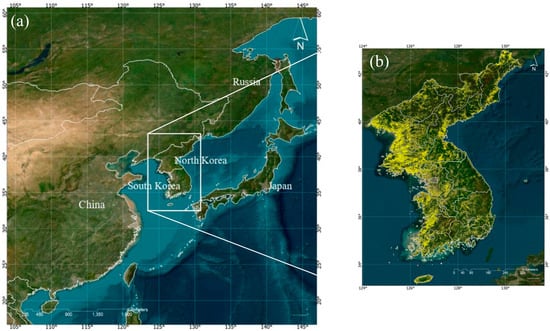
Figure 1.
(a) Location of study area: South Korea and North Korea. (b) Cropland in the 2010s based on land cover map provided by the Ministry of Environment (South Korea) (Sources: Esri, DigitalGlobe, GeoEye, i-cubed, USDA FSA, USGS, AEX, Getmapping, Aerogrid, IGN, IGP, swisstopo, and the GIS User Community).
Both South Korea and North Korea have the same natural environmental conditions, such as climate and topography. However, the two countries have different socio-economic conditions, which affects the level of crop productivity and food security as well. Therefore, it is important to assess the two countries’ food security and compare their socio-economic conditions, like cropland policies.
2.2. Materials
The data used in this research included climate, topographic, agricultural, and statistical data. The climate, topographic, and agricultural data were inputs for the EPIC model. The data was collected from national databases because of their long-term coverage, and high resolution because of regional specificity, but if unavailable, we used international databases.
Climate data were collected from the Korea Meteorological Administration (KMA), which provides station-based weather data: the data for South Korea were collected from its stations, and those for North Korea were taken from the station data submitted to the World Meteorological Organization. Topographic data included Digital Elevation Model (DEM) generated using the Shuttle Radar Topography Mission (SRTM), land cover maps (1990s, 2000s, and 2010s) provided by the Ministry of Environment in South Korea, and the Modified Harmonized World Soil Database from the International Institute for Applied Systems Analysis (IIASA). Agricultural data included planting schedules, such as seedling dates, growing periods, and harvest times after germination, used to calculate crop productivity. This information was collected from the Rural Development Administration (RDA) in South Korea and used to optimize the model for the Korean peninsula’s environment. Statistical data included population figures for food demand from the World Bank data and the ratio of cultivation areas for food supply from Statistics Korea (paddy rice) and Food and Agriculture Organization (FAO) (maize). Additionally, rice and maize yield data from Statistics Korea, FAO, and the United States Department of Agriculture (USDA) were used for comparison (Table 1).

Table 1.
Data collected for EPIC model.
2.3. Methods
To assess food security, we estimated both food demand and supply and the annual food security status to identify the level of self-sufficiency in each country. Food demand was calculated using the annual population and annual amount of cereal recommended (North Korea)/actual intake (South Korea) per capita. Food supply was estimated using the major crops’ productivity from the EPIC model and the ratio of crops’ cultivated area, due to a lack of spatial data to identify the staple crop areas or ratio over thirty years. There are various crop simulation models, such as the Decision Support System for Agrotechnology Transfer (DSSAT) Model, the Elementary Crop Growth Simulator (ELCROS) Model, Crop Estimation through Resource and Environment Synthesis (CERES), and the WOFOST Model [32]. Among these models, the EPIC model is a bio-physical model and simulates long-term and large-scale crop yields adopting agro-environmental factors, like agricultural management systems and soil stress [33,34]. It was developed in 1985 by the USDA and is widely used, considering climate, soil features, level of fertilizer, and other agricultural infrastructure [35,36]. This model can estimate crop production under future climate change scenarios at the global level [37] and can be optimized for region-specific applications [38]. It also provides the distribution of potential crop productivity. Therefore, we adapted EPIC with agricultural infrastructure settings to match crop yields from statistical data in each country. After running the model, the productivity of each crop was spatialized. Agricultural infrastructure is especially important for paddy rice, such as the level of irrigation and amount of fertilizer, which highly affects rice productivity on the Korean peninsula. The spatial data were extracted from cropland maps for each decade and multiplied by the ratio of each crop’s cultivated area. Food supply from EPIC was compared with statistics from Statistics Korea (South Korea), FAO, and USDA for validation.
3. Results
3.1. Estimate of Food Demand and Supply in South Korea
Food demand in South Korea was estimated using the total population per year and the annual amount of rice intake per capita from 1991 to 2020. Unlike North Korea, the government in South Korea collected the actual amount of rice consumption. The total population increased from 43.2 million to 51.8 million [39], but the amount of intake per capita in South Korea gradually decreased from 116.3 kg (kilogram) to 57.7 kg [40]. Therefore, food demand in South Korea was reduced from 5 million tons to 2.9 million tons, almost a 58% reduction (Figure 2).
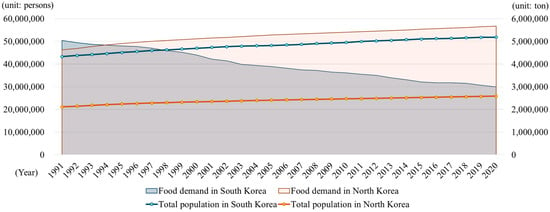
Figure 2.
Total population and food demand in South Korea and North Korea (1991–2020).
To estimate food supply, the EPIC model was run to calculate rice productivity from 1991 to 2020, spatialize the rice productivity on cropland by extracting from land cover maps, and multiply the rice productivity, the ratio of rice paddy cultivated area, and the milling rate (92.9%), converting brown rice to white rice (the higher the ratio, the lower the loss). Most of the cropland in the country was in the western regions, where the plains are. The area of paddy rice gradually decreased from 1.2 million ha in 1991 to 0.7 million ha in 2020, about a 60% reduction due to declining consumption. Over thirty years, the productivity ranged from 0.026 t/ha (hectares) to 8.675 t/ha and was more evenly distributed compared to that in North Korea. In 1997, the average rice productivity was at the lowest level and at the highest in 2014 (Figure 3). The average productivity was around 5 t/ha, and the trend was not sustainable over the last thirty years.
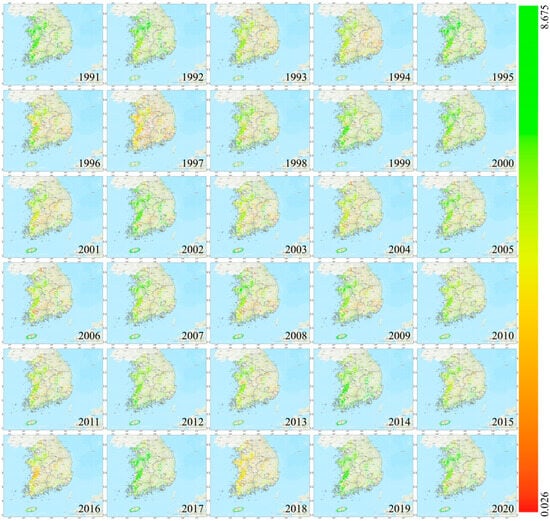
Figure 3.
The distribution of paddy rice productivity in South Korea cropland (1991–2020) (unit: t/ha) (Sources: Esri, DeLorme, HERE, TomTom, Intermap, increment P Corp., GEBCO, USGS, FAO, NPS, NRCAN, GeoBase, IGN, Kadaster NL, Ordnance Survey, Esri Japan, METI, Esri China (Hong Kong), swisstopo, MapmyIndia, and the GIS User Community).
The annual rice yield was reduced not because of the productivity level but because of the decreasing cultivated area, ranging from 5.73 million tons in 1991 to 3.95 million tons in 2020. Also, the average of each decade was 4.78 million tons in the 1990s, 4.45 million tons in the 2000s, and 3.80 million tons in the 2010s, while the productivity level was sustainable. For example, the average rice productivity was 5.18 t/ha in the 1990s, 5.13 t/ha in the 2000s, and 5.29 t/ha in the 2010s. Even though there were some gaps between the rice yields from EPIC and statistical data in 1997 and 2018, the general trends of the two datasets matched (Figure 4) [41].

Figure 4.
Rice yield between statistical data and EPIC in South Korea (unit: tons).
3.2. Estimated Food Demand and Supply in North Korea
To estimate food demand in North Korea, we adopted the total population by individual year and United Nations World Food Plan (UN WFP)’s recommended cereal amount per year. In the case of North Korea, the government does not collect data on staple food consumption, but the UN has consistently provided estimated values due to concerns about the country’s food security. According to the UN WFP, it recommends 600 g of grain per capita daily. The annual recommended amount per capita was 219 kg. The total population in North Korea has gradually increased from 21.1 million to 25.8 million [39]. Compared to South Korea, where about 50 million people live, the population in North Korea is less than half that number, but food demand in North Korea increased from 4.62 million tons in 1991 to 5.66 million tons in 2020. This represents about 22.5% growth over the last 30 years, proportional to the rate of population growth (Figure 2).
Even though the process of calculating food supply in North Korea was similar to that for South Korea, the total food supply was calculated as the sum of the amounts of annual paddy rice and maize. Also, North Korea’s milling rate is 72%, as assumed by the South Korean government due to the low level of agricultural infrastructure. The cultivated regions are on the western side of the country, similar to South Korea. The total cultivated area in North Korea has remained constant at about 1.9 million ha over the last 30 years. The area of paddy rice was about 0.59 million ha in the 1990s, 0.6 million ha in the 2000s, and 0.56 million ha in the 2010s, accounting for about 30% of the overall cultivated area [41]. The maize cultivated area was about 0.61 million ha in the 1990s, 0.5 million ha in the 2000s, and 0.53 million ha in the 2010s, accounting for about 28% [42,43].
Over the 30 years, paddy rice productivity ranged from 0.0009 t/ha to 8.184 t/ha. The minimum level of average productivity appeared in 2018 and the maximum in 2015. In general, the regions with higher productivity were in the midwestern and northwestern areas, where plains dominate. Lower productivity occurred in the southern part of North Korea (Figure 5). The average productivity rate was around 3 t/ha in the 1990s, 2000s, and 2010s. Therefore, the average rice yield was 1.65 million tons in the 1990s, and it increased to 2.29 million tons in the 2000s despite a consistent area of cultivated land. In the 2010s, it decreased to 1.74 million tons due to a reduction in cultivated area. For comparison, crop yield from EPIC and statistical data from Statistics Korea, FAO, and USDA were collected [44,45]. The annual rice yield from EPIC during the 2000s was overestimated compared to the other data, but the general trends of these data were similar (Figure 6).
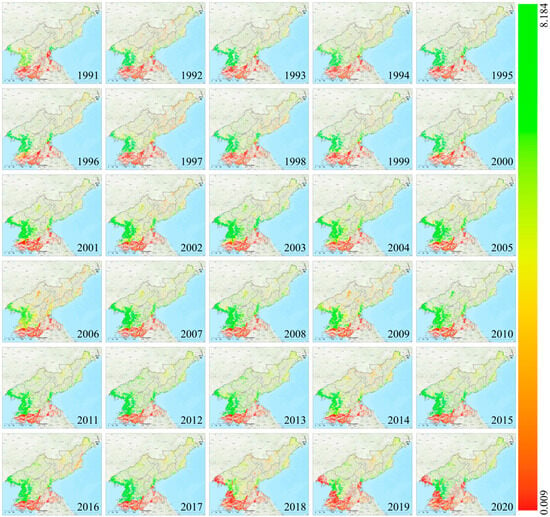
Figure 5.
The distribution of paddy rice productivity in North Korea cropland (1991–2020) (unit: t/ha) (Sources: Esri, DeLorme, HERE, TomTom, Intermap, increment P Corp., GEBCO, USGS, FAO, NPS, NRCAN, GeoBase, IGN, Kadaster NL, Ordnance Survey, Esri Japan, METI, Esri China (Hong Kong), swisstopo, MapmyIndia, and the GIS User Community).
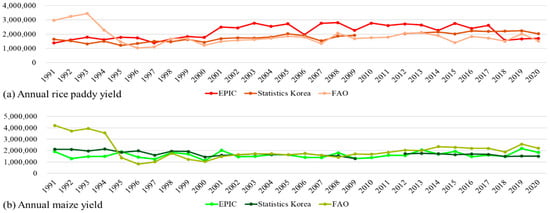
Figure 6.
Comparison of crop yield (paddy rice and maize) between statistical data and EPIC in North Korea: (a) annual rice paddy yield and (b) annual maize yield.
In the case of maize cultivation, the range of productivity was 0.409–7.108 t/ha. The lowest average productivity appeared in 1992, and the highest in 2001. Compared to paddy rice productivity, maize productivity was equally distributed spatially and temporally. There were maize productivity gaps between the regions, but they were not dramatically wider than in the case of rice. The outcomes show that topographic conditions did not have much influence on maize cultivation, unlike paddy rice. Also, the time-series productivity was consistent. For example, the average productivity per decade was around 2.5 t/ha (Figure 7). As a result, the average maize yield was 1.54 million tons in the 1990s and 1.55 million tons in the 2000s. However, in the 2010s, it increased to 1.74 million tons due to expansion of the maize cultivated area (Figure 6). The annual maize yield from the model is consistent with the other data but sometimes underestimated.
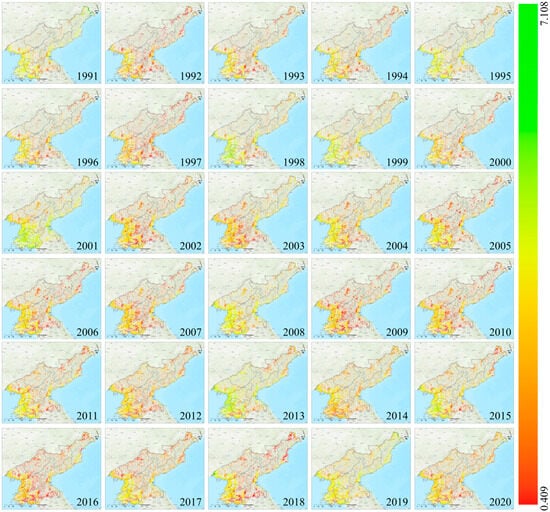
Figure 7.
The distribution of maize productivity in North Korea cropland (1991–2020) (unit: t/ha) (Sources: Esri, DeLorme, HERE, TomTom, Intermap, increment P Corp., GEBCO, USGS, FAO, NPS, NRCAN, GeoBase, IGN, Kadaster NL, Ordnance Survey, Esri Japan, METI, Esri China (Hong Kong), swisstopo, MapmyIndia, and the GIS User Community).
The food supply was calculated as the total amount of paddy rice and maize per year. It was highly affected by rice yield because rice yield was generally larger than that of maize. For example, in 2006, 2009 and 2018, even though the amount of maize was the same as the previous years, that of rice declined dramatically. This resulted in a decreased supply. However, food supply peaked at over 4.5 million tons per year in 2001, 2008, 2013, and 2015 because of higher crop yields (Figure 8).

Figure 8.
Food supply in North Korea: total amount of paddy rice and maize yields per year.
3.3. Assess Food Security from 1991 to 2020
Food security in South Korea for the last 30 years was assessed using food demand and supply. The country’s food demand has decreased since 1991 despite population growth from 43 million to 51 million because of a sharp reduction in rice consumption by 50% (116.3 kg to 57.7 kg). In general, the food supply was sufficient to meet the demand except for one year. In the 1990s, the average demand was 4.7 million tons and the average supply was 6.0 million tons. Even though the supply did not match the demand in 1997, food was secured in the other 9 years. During this period, the average demand and supply were higher than in other periods because of high rice consumption and a high ratio of paddy rice cultivation. Therefore, the gap was the narrowest compared to the other two decades, the 2000s and 2010s. In the 2000s, both the average food demand and supply dropped compared to the previous decade, by 3.8 million tons and 5.6 million tons, respectively. During this period, the food supply matched the demand. The gap between average demand and supply was wider than in other decades, at 1.7 million tons, due to a slowdown in population growth and a slow reduction in paddy rice cultivated areas. In the final period, the 2010s, the average food demand was 3.2 million tons and the average supply was 4.7 million tons. As in the previous decade, food supply met the demand. The average demand and supply were lowest compared to the other two decades due to a gradual reduction in rice consumption, population growth rate, and area of paddy rice cultivation. However, the gap was 1.4 million tons, which was not the lowest (Figure 9).
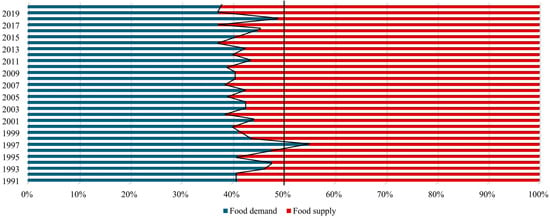
Figure 9.
Food security assessment using food demand and supply in South Korea (1991–2020).
Assessment of food security in North Korea was conducted the same way as in South Korea. Food demand gradually increased from 1991 due to population growth from 21 million to 25 million, despite a consistently recommended cereal amount. However, the food supply was not enough to satisfy the increasing demand for 30 years. The average food demand in the 1990s was 4.9 million tons and the average supply was 3.2 million tons. This period was the most insecure of the three decades assessed. Even though the cultivated areas for two major crops were the largest, especially maize, the average food supply was the lowest. Also, population growth was greater than in the other periods. Therefore, the difference between average supply and demand was severe. In the 2000s, both the average demand and supply increased compared to the previous period. The average demand was 5.3 million tons and that of supply was 4.1 million tons. Population growth began to slow down, and areas of paddy rice increased by reducing the area of maize. The 2000s remained a period of food insecurity, but the gap between demand and supply was lower than in the other two decades. In the last decade, the 2010s, food insecurity worsened compared to the 2000s. The average food demand was 5.5 million tons and the average supply was 4.0 million tons. The food demand was the highest at this time because of the increase in population. However, the cropland for major crops was lower than in other periods, especially for paddy rice. Therefore, the supply did not match the food demand, and North Korea remained food insecure (Figure 10).
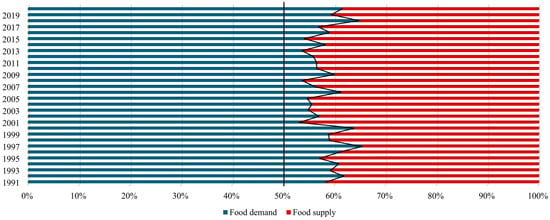
Figure 10.
Food security assessment using food demand and supply in North Korea (1991–2020).
4. Discussion
This study assessed food security in South Korea and North Korea from 1991 to 2020. Previous studies have mainly focused on estimating crop yields [28,29,30,31]. However, this study adopted not only food supply (crop yields) but also demand to evaluate the food security of the two countries over 30 years. They have the same environmental conditions but have had different socio-economic environments after the Korean War. Therefore, it is significant to assess the food security of both countries to understand the discrepancies affecting food insecurity.
According to the food security assessment, South Korea achieved food security except in 1997, but North Korea was food insecure from 1991 to 2020 (Figure 9). These results originated from not only food demand but also the supply. In the case of food demand, South Korea and North Korea have gradually increased in population, from 43 million to 51 million in South Korea and from 21 million to 25 million in North Korea. Even though the rate of population growth in South Korea was twice that in North Korea, their consumption rates of staple crops differed. North Korea maintained the recommended amount of cereal from WFP, 219 kg per year, without national statistics, but rice consumption per year in South Korea reduced from 116.3 kg to 57.7 kg based on national data. People living in South Korea have changed their dietary patterns because they have opportunities to intake diverse nutrients and alternatives since participating in trade [46]. However, North Korea is isolated from international trade and trades only with select countries, such as China and Russia [47,48]. This prevents the country from reducing their cereal dependency. In summary, South Korea experienced a population increase of about 8.5 million while halving their rice consumption due to better nutrient dietary patterns, while North Korea doubled its population while maintaining high cereal dependency.
Food supply should align with demand to achieve self-sufficiency. The average rice productivity in South Korea was more than 5.2 t/ha for 30 years. Even though the cultivated area of paddy rice has decreased, productivity has remained constant. On the other hand, in North Korea, the average rice yield was 3.58 t/ha and that of maize was 2.52 t/ha from 1991 to 2020. The major reason for this gap is the level of agricultural infrastructure. Especially when cultivating paddy rice, the irrigation level is a key factor in improving the productivity level [49]. South Korea has been repairing its agricultural waterways since the 1970s under the rural area development plans (Saemaeul Undong) (Figure 11) [50,51,52]. North Korea initiated the reformation of overall irrigation systems in the 2000s, but the quality of waterway infrastructure was still low [53,54,55]. It was inefficient in increasing crop productivity [56]. Furthermore, the two countries differ in the effectiveness of their domestic agricultural policies. In South Korea, agriculture is not the national key industry, unlike in North Korea. However, the country has concentrated on promoting heavy chemical industries under the ‘3rd Five-Year plan’ since 1972, and at the same time, it has set up a rural development plan called ‘Saemaul Undong’ to balance urban and rural areas and prevent food prices from skyrocketing [51]. According to the rural development plan, the agricultural infrastructure required to improve productivity have been successfully promoted in South Korea [57]. In the case of North Korea, it considers agriculture as its core industry. The government designed the ‘National Economic Development plan’ in 1961 to improve the agricultural and other economic sectors, but it was not successfully implemented. In particular, the three development plans before the 1990s were not completed as planned due to slow progress (Figure 11). The development plans ended in 1993, and during the 2000s, the country focused on afforestation. In the 2010s, it adopted an agroforestry approach (forest rehabilitation and development with an agroforestry approach (2013~2022)) [58], expanding cropland on the slope areas to overcome chronic food shortages. Staple crops, especially rice or maize, were cultivated on upland slopes between 8 and 15 degrees [59]. However, the effectiveness of the agricultural policies in North Korea was limited in achieving food security because most of the agricultural policies in North Korea aimed to expand the cultivated areas without considering improvement in productivity.
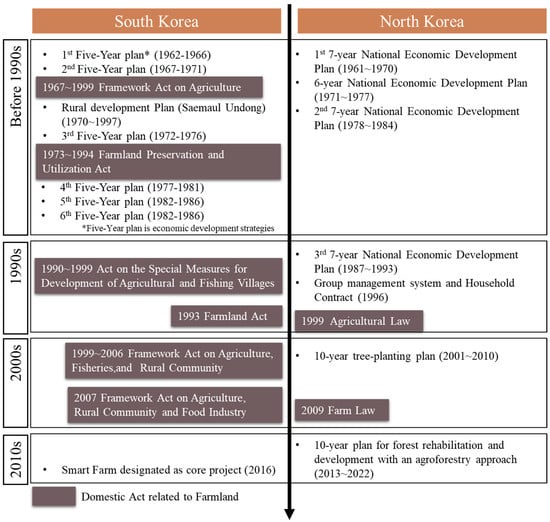
Figure 11.
Farmland- and agriculture-related strategies and legislation in South Korea and North Korea.
The assessment of food security in South Korea and North Korea showed that socio-economic discrepancies can affect the level of food security under the same environmental conditions. Therefore, the North Korean government should consider balanced nutrition and effective agricultural policies. The country faces a lack of dietary diversity with high cereal demand, almost four times higher than that in South Korea. This unbalanced nutrition intake lowers the level of food security. In this sense, South Korea has achieved both quantity and quality of food security by lowering rice dependency. Also, the agricultural policies of South Korea have been effective in promoting paddy rice productivity in spite of a decrease in paddy rice areas. In North Korea, the productivity level is lower than that of South Korea because of ineffective policies. This country should develop policies reflecting not only quantity (areas) but also quality (productivity), rather than focusing on only one aspect.
In the long term, it is essential to consider climate change impacts. Climate is the core variable in cultivating crops, and its change will shift productivity levels and growing conditions. Some studies have already covered the potential crop productivity and yields under climate change [60,61,62], and others have suggested considering climate extremes for cultivating crops [63]. In particular, North Korea, which has poor infrastructure for cultivation, is highly vulnerable to the impacts of climate change. To reduce its vulnerability, adaptive capacity should be improved. This means that under the same environmental conditions, the level of adaptive capacity will determine the level of vulnerability to damages [64]. Agriculture is one of the main sectors to be directly impacted by climate change and climate extremes. Therefore, it is essential to improve the adaptive capacity of agriculture to achieve food security. In the future, food will not be an independent sector but interdependent on others, such as bioenergy, water management, etc. It is important to combine agriculture with these sectors for sustainable food production [4,65].
This study did not specifically spatialize the crops’ productivity due to a lack of spatial data, and it used statistical data as an alternative to estimate the values. In the future, it would be better to identify staple crops’ locations in the Korean peninsula via the classification of crop characteristics and to estimate accurate productivity and yields. Even though this research was executed under a lack of data, it covered a relatively long period, 30 years, to assess food security, considering both food demand and supply, unlike previous studies.
5. Conclusions
The international community has made significant efforts to reduce hunger and famine by supporting food aid and technology transfer to improve crop yields. Increasing domestic crop productivity is one of the key methods to secure food security under the concept of self-sufficiency. Previous studies have aimed at estimating or predicting crop yield on the Korean peninsula. South Korea and North Korea share the same natural environment but have experienced different socio-economic conditions for about 80 years. This study assessed food security in two countries over the last thirty years (1991~2020), adopting both food demand and supply perspectives. The results indicate that South Korea has achieved food security because of balanced nutrition, well-managed agricultural infrastructure, and effectively implemented policies. On the other hand, North Korea has not secured adequate food supplies and has suffered from chronic food shortages, unbalanced nutrition, poor infrastructure, and ineffective policy promotion. A limitation of this study is that it did not spatialize the crop productivity due to a lack of data. For future research, classifying the land cover is recommended to identify paddy rice and maize productivity on the Korean peninsula. This will contribute to improving the accuracy of crop production estimates.
This study suggests that the socio-economic environment can significantly improve crop productivity. This will become even more important under climate change. Therefore, countries should adapt climate-smart technologies for sustainable food production before climate change adversely affects national crop productivity.
Author Contributions
Conceptualization, W.K. and W.-K.L.; methodology, W.K., R.S., C.F., D.S. and S.L.; validation, W.K.; investigation, W.K.; data curation, W.K. and R.S.; writing—original draft preparation, W.K.; writing—review and editing, W.K., D.S. and J.K.; visualization, W.K.; supervision, F.K., C.-G.K., S.-W.J., Y.S. and W.-K.L. All authors have read and agreed to the published version of the manuscript.
Funding
This research was supported by the National Research Foundation of Korea Grant funded by the Korea government (MSIT) (NRF-2021K1A3A1A78097879) and by the OJEong Resilience Institute (OJERI) at Korea University under the Basic Science Research Program, National Research Foundation of Korea (NRF) (NRF-2021R1A6A1A10045235).
Data Availability Statement
The data presented in this study are available in the article.
Acknowledgments
W.K. acknowledges that this work was performed under the auspices of the Young Scientists Summer Program (YSSP) of the International Institute of Applied Systems Analysis (IIASA).
Conflicts of Interest
The authors declare no conflicts of interest.
References
- Kummu, M.; Fader, M.; Gerten, D.; Guillaume, J.H.; Jalava, M.; Jägermeyr, J.; Pfister, S.; Porkka, M.; Siebert, S.; Varis, O. Bringing It All Together: Linking Measures to Secure Nations’ Food Supply. Curr. Opin. Environ. Sustain. 2017, 29, 98–117. [Google Scholar] [CrossRef]
- Haberl, H.; Erb, K.-H. Land as a Planetary Boundary: A Socioecological Perspective. In Handbook on Growth and Sustainability; Edward Elgar Publishing: Cheltenham, UK, 2017. [Google Scholar] [CrossRef]
- Duro, J.A.; Lauk, C.; Kastner, T.; Erb, K.H.; Haberl, H. Global Inequalities in Food Consumption, Cropland Demand and Land-Use Efficiency: A Decomposition Analysis. Glob. Environ. Change 2020, 64, 102124. [Google Scholar] [CrossRef]
- Vera, I.; Wicke, B.; Lamers, P.; Cowie, A.; Repo, A.; Heukels, B.; Zumpf, C.; Styles, D.; Parish, E.; Cherubini, F.; et al. Land Use for Bioenergy: Synergies and Trade-Offs between Sustainable Development Goals. Renew. Sustain. Energy Rev. 2022, 161, 112409. [Google Scholar] [CrossRef]
- Food Security Information Network and Global Network Against Food Crises. 2024 Global Report on Food Crises; Food Security Information Network and Global Network Against Food Crises: Rome, Italy, 2023. [Google Scholar]
- Beltran-Peña, A.; Rosa, L.; D’Odorico, P. Global Food Self-Sufficiency in the 21st Century under Sustainable Intensification of Agriculture. Environ. Res. Lett. 2020, 15, 095004. [Google Scholar] [CrossRef]
- El Bilali, H.; Bassole, I.H.N.; Dambo, L.; Berjan, S. Climate Change and Food Security. Agric. For. 2020, 66, 197–210. [Google Scholar] [CrossRef]
- Abah, R.C.; Petja, B.M. The Socio-Economic Factors Affecting Agricultural Development in the Lower River Benue Basin. J. Biol. Agric. Healthc. 2015, 5, 84–94. [Google Scholar]
- Fischer, G.; Shah, M.; Tubiello, F.N.; Van Velhuizen, H. Socio-Economic and Climate Change Impacts on Agriculture: An Integrated Assessment, 1990–2080. Philos. Trans. R. Soc. B Biol. Sci. 2005, 360, 2067–2083. [Google Scholar] [CrossRef]
- Olesen, J.E. Socio-Economic Impacts—Agricultural Systems. In North Sea Region Climate Change Assessment; SpringerOpen: New York, NY, USA, 2016; pp. 397–407. [Google Scholar]
- Borowski, P.F.; Patuk, I. Environmental, Social and Economic Factors in Sustainable Development with Food, Energy and Eco-Space Aspect Security. Present Environ. Sustain. Dev. 2021, 15, 153–169. [Google Scholar] [CrossRef]
- Keovilignavong, O.; Suhardiman, D. Linking Land Tenure Security with Food Security: Unpacking Farm Households’ Perceptions and Strategies in the Rural Uplands of Laos. Land Use Policy 2020, 90, 104260. [Google Scholar] [CrossRef]
- Liu, Y.; Zhou, Y. Reflections on China’s Food Security and Land Use Policy under Rapid Urbanization. Land Use Policy 2021, 109, 105699. [Google Scholar] [CrossRef]
- Putra, A.S.; Tong, G.; Pribadi, D.O. Food Security Challenges in Rapidly Urbanizing Developing Countries: Insight from Indonesia. Sustain. 2020, 12, 9550. [Google Scholar] [CrossRef]
- Huang, Q.; Liu, Z.; He, C.; Gou, S.; Bai, Y.; Wang, Y.; Shen, M. The Occupation of Cropland by Global Urban Expansion from 1992 to 2016 and Its Implications. Environ. Res. Lett. 2020, 15, 084037. [Google Scholar] [CrossRef]
- Qiu, B.; Li, H.; Tang, Z.; Chen, C.; Berry, J. How Cropland Losses Shaped by Unbalanced Urbanization Process? Land Use Policy 2020, 96, 104715. [Google Scholar] [CrossRef]
- Viana, C.M.; Freire, D.; Abrantes, P.; Rocha, J.; Pereira, P. Agricultural Land Systems Importance for Supporting Food Security and Sustainable Development Goals: A Systematic Review. Sci. Total Environ. 2022, 806, 150718. [Google Scholar] [CrossRef] [PubMed]
- Avtar, R.; Aggarwal, R.; Kharrazi, A.; Kumar, P.; Kurniawan, T.A. Utilizing Geospatial Information to Implement SDGs and Monitor Their Progress. Environ. Monit. Assess. 2020, 192, 35. [Google Scholar] [CrossRef] [PubMed]
- Anghinoni, G.; Anghinoni, F.B.G.; Tormena, C.A.; Braccini, A.L.; de Carvalho Mendes, I.; Zancanaro, L.; Lal, R. Conservation Agriculture Strengthen Sustainability of Brazilian Grain Production and Food Security. Land Use Policy 2021, 108, 105591. [Google Scholar] [CrossRef]
- Schultze, M.; Kankam, S.; Sanfo, S.; Fürst, C. Agricultural Yield Responses to Climate Variabilities in West Africa: A Food Supply and Demand Analysis. Land 2024, 13, 364. [Google Scholar] [CrossRef]
- Lan, Y.; Xu, B.; Huan, Y.; Guo, J.; Liu, X.; Han, J.; Li, K. Food Security and Land Use under Sustainable Development Goals: Insights from Food Supply to Demand Side and Limited Arable Land in China. Foods 2023, 12, 4168. [Google Scholar] [CrossRef]
- Qi, X.; Vitousek, P.M.; Liu, L. Provincial Food Security in China: A Quantitative Risk Assessment Based on Local Food Supply and Demand Trends. Food Secur. 2015, 7, 621–632. [Google Scholar] [CrossRef]
- Keating, B.A.; Herrero, M.; Carberry, P.S.; Gardner, J.; Cole, M.B. Food Wedges: Framing the Global Food Demand and Supply Challenge towards 2050. Glob. Food Sec. 2014, 3, 125–132. [Google Scholar] [CrossRef]
- Rosegrant, M.W.; Tokgoz, S.; Bhandary, P. The New Normal? A Tighter Global Agricultural Supply and Demand Relation and Its Implications for Food Security. Am. J. Agric. Econ. 2013, 95, 303–309. [Google Scholar] [CrossRef]
- Maya Gopal, P.S.; Bhargavi, R. A Novel Approach for Efficient Crop Yield Prediction. Comput. Electron. Agric. 2019, 165, 104968. [Google Scholar] [CrossRef]
- Nevavuori, P.; Narra, N.; Lipping, T. Crop Yield Prediction with Deep Convolutional Neural Networks. Comput. Electron. Agric. 2019, 163, 104859. [Google Scholar] [CrossRef]
- Folberth, C.; Baklanov, A.; Balkovič, J.; Skalský, R.; Khabarov, N.; Obersteiner, M. Spatio-Temporal Downscaling of Gridded Crop Model Yield Estimates Based on Machine Learning. Agric. For. Meteorol. 2019, 264, 1–15. [Google Scholar] [CrossRef]
- Hong, S.Y.; Hur, J.; Ahn, J.-B.; Lee, J.-M.; Min, B.-K.; Lee, C.-K.; Kim, Y.; Lee, K.D.; Kim, S.-H.; Kim, G.Y.; et al. Estimating Rice Yield Using MODIS NDVI and Meteorological Data in Korea. Korean J. Remote Sens. 2012, 28, 509–520. [Google Scholar] [CrossRef]
- Jeong, S.; Ko, J.; Yeom, J.M. Nationwide Projection of Rice Yield Using a Crop Model Integrated with Geostationary Satellite Imagery: A Case Study in South Korea. Remote Sens. 2018, 10, 1665. [Google Scholar] [CrossRef]
- Ma, B.; Zhang, B.; Jia, L.; Huang, H. Conditional Distribution Selection for SPEI-Daily and Its Revealed Meteorological Drought Characteristics in China from 1961 to 2017. Atmos. Res. 2020, 246, 105108. [Google Scholar] [CrossRef]
- Jeong, S.; Ko, J.; Yeom, J.M. Predicting Rice Yield at Pixel Scale through Synthetic Use of Crop and Deep Learning Models with Satellite Data in South and North Korea. Sci. Total Environ. 2022, 802, 149726. [Google Scholar] [CrossRef]
- Kosamkar, P.K.; Kulkarni, V.Y. Agriculture Crop Simulation Models Using Computational Intelligence. Int. J. Comput. Eng. Technol. 2019, 10, 134–140. [Google Scholar] [CrossRef]
- Izaurralde, R.C.; Williams, J.R.; McGill, W.B.; Rosenberg, N.J.; Jakas, M.C.Q. Simulating Soil C Dynamics with EPIC: Model Description and Testing Against Long-Term Data. Ecol. Modell. 2006, 192, 362–384. [Google Scholar] [CrossRef]
- Lim, C.H.; Choi, Y.; Kim, M.; Jeon, S.W.; Lee, W.K. Impact of Deforestation on Agro-Environmental Variables in Cropland, North Korea. Sustainability 2017, 9, 1354. [Google Scholar] [CrossRef]
- Williams, J.R.; Jones, C.A.; Kiniry, J.R.; Spanel, D.A. EPIC Crop Growth Model. Trans. Am. Soc. Agric. Eng. 1989, 32, 497–511. [Google Scholar] [CrossRef]
- White, J.W.; Hoogenboom, G.; Kimball, B.A.; Wall, G.W. Methodologies for Simulating Impacts of Climate Change on Crop Production. Field Crops Res. 2011, 124, 357–368. [Google Scholar] [CrossRef]
- Balkovič, J.; van der Velde, M.; Skalský, R.; Xiong, W.; Folberth, C.; Khabarov, N.; Smirnov, A.; Mueller, N.D.; Obersteiner, M. Global Wheat Production Potentials and Management Flexibility under the Representative Concentration Pathways. Glob. Planet. Change 2014, 122, 107–121. [Google Scholar] [CrossRef]
- Folberth, C.; Gaiser, T.; Abbaspour, K.C.; Schulin, R.; Yang, H. Regionalization of a Large-Scale Crop Growth Model for Sub-Saharan Africa: Model Setup, Evaluation, and Estimation of Maize Yields. Agric. Ecosyst. Environ. 2012, 151, 21–33. [Google Scholar] [CrossRef]
- World Bank the Total Population in South Korea and North Korea. Available online: https://databank.worldbank.org/source/world-development-indicators (accessed on 8 May 2024).
- Statistical Korea Annual Rice Consumption per Capita. Available online: https://kosis.kr/statHtml/statHtml.do?orgId=101&tblId=DT_1ED0001&conn_path=I2 (accessed on 2 April 2024).
- Statistical Korea Rice Production (Polished). Available online: https://kosis.kr/statHtml/statHtml.do?orgId=101&tblId=DT_1ET0221&conn_path=I2 (accessed on 6 June 2023).
- Food and Agriculture Organization (FAO). The Cultivated Areas of Maize and Rice in North Korea (1981~2022). Available online: https://www.fao.org/faostat/en/#data/QCL (accessed on 29 August 2024).
- Food and Agriculture Organization (FAO). Arable Land in North Korea (1964~2020). Available online: https://www.fao.org/faostat/en/#data/RL (accessed on 3 September 2024).
- Statistical Korea Composition of Cultivated Land in South Korea and North Korea. Available online: https://kosis.kr/statHtml/statHtml.do?sso=ok&returnurl=https%3A%2F%2Fkosis.kr%3A443%2FstatHtml%2FstatHtml.do%3Fconn_path%3DI3%26tblId%3DDT_1ZGA54%26orgId%3D101%26 (accessed on 6 June 2023).
- Food and Agriculture Organization (FAO). Rice and Maize Production in North Korea (1961~2022). Available online: https://www.fao.org/faostat/en/#data/QCL (accessed on 29 August 2024).
- Jeong, O.Y.; Park, H.S.; Baek, M.K.; Kim, W.J.; Lee, G.M.; Lee, C.M.; Bombay, M.; Ancheta, M.B.; Lee, J.H. Review of Rice in Korea: Current Status, Future Prospects, and Comparisons with Rice in Other Countries. J. Crop Sci. Biotechnol. 2021, 24, 1–11. [Google Scholar] [CrossRef]
- Ducruet, C.; Yoon, I.J. Maritime Trade and Economic Development in North Korea. J. Transp. Geogr. 2024, 120, 103990. [Google Scholar] [CrossRef]
- Noland, M. North Korea as a Complex Humanitarian Emergency: Assessing Food Insecurity. Asia Glob. Econ. 2022, 2, 100049. [Google Scholar] [CrossRef]
- Zhang, Y.; Liu, G.; Huang, W.; Xu, J.; Cheng, Y.; Wang, C.; Zhu, T.; Yang, J. Effects of Irrigation Regimes on Yield and Quality of Upland Rice and Paddy Rice and Their Interaction with Nitrogen Rates. Agric. Water Manag. 2020, 241, 106344. [Google Scholar] [CrossRef]
- Choi, I.C.; Shin, H.J.; Nguyen, T.T.; Tenhunen, J. Water Policy Reforms in South Korea: A Historical Review and Ongoing Challenges for Sustainable Water Governance and Management. Water 2017, 9, 717. [Google Scholar] [CrossRef]
- Park, S. Analysis of Saemaul Undong: A Korean Rural Development Programme in the 1970s. Asia-Pac. Dev. J. 2012, 16, 113–140. [Google Scholar] [CrossRef]
- Hwang, J.; Seo, Y.; Jung, J.Y. Implication of the Saemaul Undong on Water Resources Development in Rural Communities during 1970’s. J. Korean Soc. Water Wastewater 2016, 30, 699–705. [Google Scholar] [CrossRef]
- Koen, V.; Beom, J. North Korea: The Last Transition Economy? OECD Economics Department Working Papers; OECD Publishing: Paris, France, 2020; Volume 1607. [Google Scholar] [CrossRef]
- Rhie, J.-H.; Lee, K.-S.; Seo, I.-H.; Min, S.-W.; Chung, D.-Y. Assessing the Limits of Agricultural Situation for the Food Security in North Korea. Korean J. Soil Sci. Fertil. 2017, 50, 275–284. [Google Scholar] [CrossRef]
- Ryu, J.-H.; Han, K.-S.; Lee, Y.-W.; Park, N.-W.; Hong, S.; Chung, C.; Cho, J. Different Agricultural Responses to Extreme Drought Events in Neighboring Counties of South and North Korea. Remote Sens. 2019, 11, 1773. [Google Scholar] [CrossRef]
- Llanto, G.M. The Impact of Infrastructure on Agricultural Productivity; Philippine Institute for Development Studies: Makati City, Philippines, 2012; pp. 469–486. [Google Scholar]
- Douglass, M. The Saemaul Undong in Historical Perspective and in the Contemporary World. In Learning from the South Korean Developmental Success; Palgrave Macmillan: London, UK, 2014; pp. 136–171. [Google Scholar]
- He, J.; Xu, J. Is There Decentralization in North Korea? Evidence and Lessons from the Sloping Land Management Program 2004–2014. Land Use Policy 2017, 61, 113–125. [Google Scholar] [CrossRef]
- Oh, S.U.; Kim, E.H.; Kim, K.M. Characteristics of Forest Policy in the Kim Jong-Un Era. North Korean Study 2018, 14, 101–133. [Google Scholar]
- Sun, H.; Ma, J.; Wang, L. Changes in per Capita Wheat Production in China in the Context of Climate Change and Population Growth. Food Secur. 2023, 15, 597–612. [Google Scholar] [CrossRef]
- Carr, T.W.; Addo, F.; Palazzo, A.; Havlik, P.; Pérez-Guzmán, K.; Ali, Z.; Green, R.; Hadida, G.; Segnon, A.C.; Zougmoré, R.; et al. Addressing Future Food Demand in The Gambia: Can Increased Crop Productivity and Climate Change Adaptation Close the Supply–Demand Gap? Food Secur. 2024, 16, 691–704. [Google Scholar] [CrossRef]
- Gebre, G.G.; Amekawa, Y.; Fikadu, A.A.; Rahut, D.B. Do Climate Change Adaptation Strategies Improve Farmers’ Food Security in Tanzania? Food Secur. 2023, 15, 629–647. [Google Scholar] [CrossRef]
- Deng, S.; Tan, X.; Liu, B. Impacts of Changes in Climate Extremes on Maize Yields over Mainland China. Food Secur. 2024, 17, 185–205. [Google Scholar] [CrossRef]
- Engle, N.L. Adaptive Capacity and Its Assessment. Glob. Environ. Change 2011, 21, 647–656. [Google Scholar] [CrossRef]
- Prudhomme, R.; De Palma, A.; Dumas, P.; Gonzalez, R.; Leadley, P.; Levrel, H.; Purvis, A.; Brunelle, T. Combining Mitigation Strategies to Increase Co-Benefits for Biodiversity and Food Security. Environ. Res. Lett. 2020, 15, 114005. [Google Scholar] [CrossRef]
Disclaimer/Publisher’s Note: The statements, opinions and data contained in all publications are solely those of the individual author(s) and contributor(s) and not of MDPI and/or the editor(s). MDPI and/or the editor(s) disclaim responsibility for any injury to people or property resulting from any ideas, methods, instructions or products referred to in the content. |
© 2025 by the authors. Licensee MDPI, Basel, Switzerland. This article is an open access article distributed under the terms and conditions of the Creative Commons Attribution (CC BY) license (https://creativecommons.org/licenses/by/4.0/).